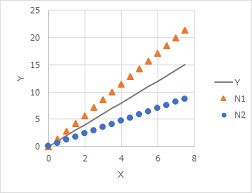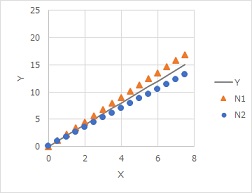
Quality engineering uses the error factor as the disturbance to realize the robust design .
The factor that represents the disturbance is the error factor.
For example, if a product is likely to be used in the range of from -10 to 40 degree C, this is a candidate error factor. For two levels of error factors, experiment from -10 to 40 degree C.
The case that often appears in the explanation of quality engineering is the one shown in the figure below.

For example, if it is 0, it is assumed that it will fall into this range.
When the control factor is selected differently, we look for conditions that narrow the range of N1 and N2. For example, if the selection of control factors makes a difference between the left and right graphs below, the right side is more robust under desirable conditions.


Disturbances can cause quality abnormalities. Error factors try to deal with disturbances. However, there are difficulties in using error factors because they deal with disturbances.
The error factors, such as the example above, determine the upper and lower sides of the variability in the data.
Of course, if you can assume these error factors, it is better to experiment, but not all of them are such error factors.
In the evaluation by error factors proposed by quality engineering, the factors that affect the characteristics can be grasped in advance. The stage of selecting a combination of them is envisaged.
If you have an experience where the process has become abnormal due to an unexpected factor, It is very difficult to say that there are no unknown error factors. Therefore, when we started mass production using the results of the experiment, There is still the possibility of being swayed by unknown error factors.
In the quality engineering manual, the number of error factors is 1 or 2 in the experiment that appears as an example.
If there are many error factors, it is called "blending". There is a method of combining those that work positively and those that work negatively into one factor. However, formulation is possible only if there is no interaction between the error factors. Deciding whether to implement a formulation is a difficult one.
NEXT 

 Applied Experiment of Signal Factor
Applied Experiment of Signal Factor
